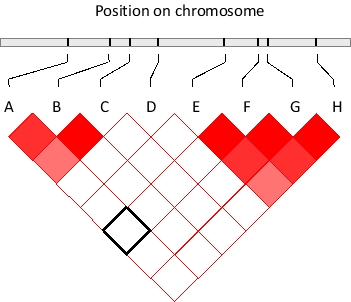If two genomic polymorphic sites were randomly and independently associated with each other, one would expect the frequency of observing a combination of their allelic forms in an individual to be equal to the multiplication product of the probability of the alleles occurring separately. In many cases, however, this is not true. The degree of deviation from random association can be quantified and summarized in diagrams such as the one below. In this diagram, eight SNPs in a genomic region are shown and their pairwise deviation from random association is color-coded by different shades of red, such that the darkest red shade indicates the furthest deviation from random association. In contrast, those pairs that associate randomly are colored white. For example, SNPs A and F seem to associate randomly as indicated by the corresponding box marked with black borders. From this diagram, two haplotype blocks can be readily detected. What subset of the shown SNPs is not part of any of the two blocks? Write down the letter(s) as your answer, in alphabetical order, e.g. CEH. 
Correct Answer:
Verified
View Answer
Unlock this answer now
Get Access to more Verified Answers free of charge
Q42: Consider a biochemical pathway in petal cells
Q43: Indicate whether each of the following descriptions
Q44: Two loci on a human chromosome are
Q45: A piece of DNA has been sequenced
Q46: Susceptibility to drug and alcohol addiction is
Q48: A piece of DNA has been sequenced
Q49: In a bacterium that is normally cylindrical
Q50: A portion of RNA-seq data obtained from
Q51: For a complementation test to work, the
Q52: In Sanger sequencing, does each labeled DNA
Unlock this Answer For Free Now!
View this answer and more for free by performing one of the following actions

Scan the QR code to install the App and get 2 free unlocks

Unlock quizzes for free by uploading documents